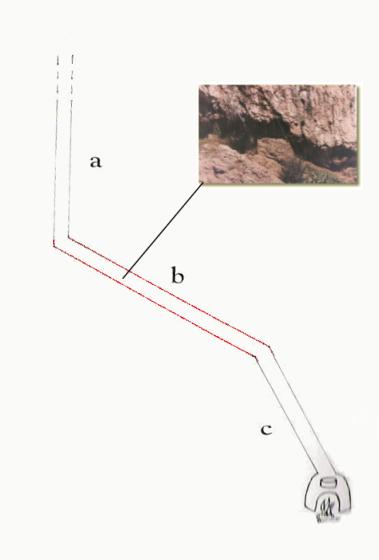The middle section of the chimney used by Phidias and others to melt the bronze for their monumental sculptures has been discovered at the base of the Acropolis rock in Athens by sculptor, Nigel Konstam.


a.) The hypothetical vertical tower chimney build on a platform of rock at the top of section b. b.) Is the diagonal section of the chimney discovered on the acropolis with abundant evidence of having been used as a chimney to a wood-fired furnace - e.g. sooty deposits and discolouration by heat. c.) The hypothetical lower section of the chimney leading down to the furnace at the base of the cliff. The inset shows a photograph of the diagonal section.
The chimney itself is huge: two meters in diameter and twenty meters long in the discovered portion (Photo 5). It is a channel cut in the rock face the section is the shape of a question mark upside down The cylinder would have been completed with brick or stone laid on the rim of stone at the hook end arching up to meet the rock face some five feet above (Photo 1). It ascends at an angle of approximately 40 degrees (the angle of the natural strata (Photo 5). There is no visible evidence of the upper and lower sections on the surface however Nigel Konstam hypothesises that, if excavated the lower section would reveal the site of an ancient furnace. Sections a and c would have been made of brick or stone that has probably been put to other uses over the centuries. This chimney could provide more than sufficient draft for the huge casts made on the Acropolis from 520 BC onwards.
Konstam has been concerning himself with the technique used by Phidias or his assistants for the making of the two Riace Heroes, now in the museum at Reggio Calabria. He found himself unable to accept the general archaeologists' view that bellows were used to create the draft for the furnace. This view is based on vase paintings, in particular the Foundry Cup in Berlin. Konstam, who has run his own basic foundry where invention took the place of investment, says it just would not work for the 300 kg of bronze necessary to pour the torso and legs of one of the monumental bronzes of the period such as the Riace bronzes (torso and legs were poured in one piece.)He estimates that with 6 strong slaves one might possibly melt 1/20th of the bronze required.
Konstam started by inventing a practical furnace using the materials available to the Greeks. He knew a chimney was necessary but when he set out for Athens to look for it he had no illusions as to how much evidence there might be left after an interval of over 2000 years. There is a well-recognised foundry area at the foot of the south face of the Acropolis where a pouring pit was excavated in 1936 by a German team. Konstam's chimney starts about ten meters up the cliff and within 30 m of the large pouring pit already excavated but he expects there was another pit within 2 or 3 meters of the furnace at the base of the chimney to allow the bronze to flow direct from the furnace into the mould without being cooled by a 30 m journey.
In attempting to get to inspect the dark brown, grey and black stains on surface of the rock, he found himself in a large "C-shaped" section cut into the rock. The orange to rust colour of this section created by heat (Photo 7) immediately confirmed that he had found what he was looking for. 'It was a gift from God' he said.
Konstam feels quite confident that when the dark grey deposits on the upper surface are analysed they will turn out to be oxides of the four elements of bronze lead, zinc, tin, and copper. Above the channel the rock surface is still streaked with black (Photo 4) where the smoke escaped but at the top of the channel where one would expect to find an explosion of pollution, if it were the top of the chimney, there is nothing much to see. Konstam hypothesises that a free-standing vertical chimney joined the diagonal section at this point. The top of the chimney would therefore have been pouring out heavy pollution over the centuries within 150 m of the west face of the Parthenon and the building does indeed shows every sign of early smoke pollution.
The chimney, its three sections combined, might have been as much as 40 m in over all length: an industrial revolution from the Golden Age of sculpture.
Tel Nigel Konstam: 0039-0577-948312

